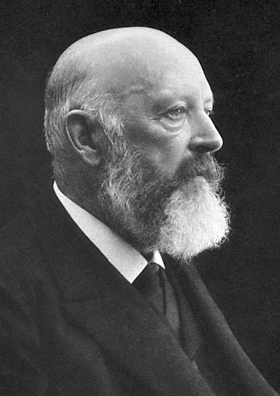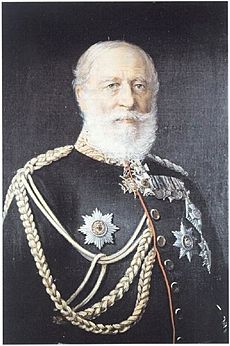Adolf von Baeyer facts for kids
Quick facts for kids
Adolf von Baeyer
|
|
|---|---|

Baeyer in 1905
|
|
| Born |
Johann Friedrich Wilhelm Adolf Baeyer
31 October 1835 |
| Died | 20 August 1917 (aged 81) Starnberg, (Bavaria) German Empire
|
| Nationality | German |
| Alma mater | University of Berlin |
| Known for | Synthesis of indigo, phenolphthalein and fluorescein Photogeochemistry Baeyer nomenclature Baeyer reagent Baeyer strain Baeyer–Drewson indigo synthesis Baeyer–Emmerling indole synthesis Baeyer–Villiger oxidation |
| Spouse(s) |
Adelheid Bendemann
(m. 1868) |
| Children | 3; including Otto. |
| Awards | Davy Medal (1881) Liebig Medal (1903) Nobel Prize for Chemistry (1905) Elliott Cresson Medal (1912) |
| Scientific career | |
| Fields | Organic chemistry |
| Institutions | University of Berlin Gewerbe-Akademie, Berlin University of Strasbourg University of Munich |
| Thesis | De arsenici cum methylo conjunctionibus (1858) |
| Doctoral advisors | Friedrich August Kekulé Robert Bunsen |
| Doctoral students | Emil Fischer John Ulric Nef Victor Villiger Carl Theodore Liebermann Carl Gräbe Karl Andreas Hofmann |
| Influenced | Otto Hahn |
Johann Friedrich Wilhelm Adolf von Baeyer (born October 31, 1835 – died August 20, 1917) was a famous German chemist. He is best known for creating indigo in the lab. Indigo is a very important blue dye. He also created a way to name cyclic compounds, which are chemical structures that form a ring. This naming system is still used today. In 1885, he was given a special title by the King of Bavaria. In 1905, he won the Nobel Prize in Chemistry for his amazing work.
Early Life and School
Adolf von Baeyer was born in Berlin, Germany. His father, Johann Jacob Baeyer, was a well-known mapmaker and an army captain. His mother was Eugenie Baeyer. Adolf had four sisters and two brothers. Sadly, his mother passed away when he was very young.
Even though his full name was Johann Friedrich Wilhelm Adolf Baeyer, most people knew him as "Adolf Baeyer." When he turned 50, the King of Bavaria gave him a special family title, which is why "von" was added to his name.
Adolf became interested in science at a young age. As a boy, he did experiments on plants at his grandfather's farm. When he was only nine, he started doing chemistry experiments in Berlin. Three years later, he even made a new chemical compound that no one had seen before! On his 13th birthday, he bought some indigo dye to start his first experiments with dyes. This was the beginning of his life's work.
When he was in school, his chemistry teacher made him his assistant. After high school in 1853, he went to the Berlin University to study physics and mathematics. He had to pause his studies to serve in the Prussian army. In 1856, he went back to school at the University of Heidelberg. He wanted to study chemistry with a famous chemist named Robert Bunsen. After a disagreement, he changed his teacher to August Kekulé. He kept working with Kekulé even after he went back to Berlin in 1858 to finish his advanced degree, called a doctorate.
Amazing Discoveries
After getting his doctorate, Adolf von Baeyer followed Kekulé to the University of Ghent. In 1860, he became a teacher at the Royal Trade Academy in Berlin. Later, he became a professor at the University of Strasbourg in 1871. In 1875, he took over from another famous chemist, Justus von Liebig, as the Chemistry Professor at the University of Munich.
Baeyer made many important discoveries. His most famous achievement was successfully making the plant dye indigo in the lab. This was a huge step for the chemical industry. He also found out how to make other dyes called phthalein dyes.
He also studied many other chemical compounds. For example, he discovered barbituric acid in 1864. This acid is the base for a group of medicines called barbiturates. In 1869, he was the first to figure out the correct chemical formula for indole, which is a part of many important natural compounds.
In 1871, he discovered how to make phenolphthalein. This chemical is used as an indicator in chemistry experiments and also in some medicines. In the same year, he made fluorescein in the lab. Fluorescein is a bright, glowing pigment. Baeyer first called it "resorcinphthalein" because of the chemicals he used to make it. The name fluorescein became popular later.
In 1872, he experimented with phenol and formaldehyde. The sticky product he made was an early version of what would later become Bakelite, one of the first plastics.
Awards and Recognition
Adolf von Baeyer received many honors for his important work:
- In 1881, the Royal Society of London gave him the Davy Medal for his work on indigo.
- In 1884, he became an honorary member of the American Academy of Arts and Sciences.
- In 1905, he won the Nobel Prize in Chemistry. He received this award for his great contributions to organic chemistry and the chemical industry, especially for his work on dyes. He continued to work and teach until about a year before he passed away.
His name is still used in chemistry today. For example, there's the Baeyer–Villiger oxidation and Baeyer's reagent, which are specific chemical reactions and compounds. There's also the Von Baeyer nomenclature for naming chemical structures and Baeyer strain theory. This theory helps explain how atoms connect in ring shapes and was part of why he won the Nobel Prize.
In 2009, a crater on the Moon was named von Baeyer in his honor.
Personal Life
In 1868, Adolf von Baeyer married Adelheid (Lida) Bendemann. They had three children together: Eugenie, Hans, and Otto.
He passed away on August 20, 1917, in Starnberg, Germany, when he was 81 years old.
See also
 In Spanish: Adolf von Baeyer para niños
In Spanish: Adolf von Baeyer para niños
- Antimanic drugs
- Barbituric acid
- Hydantoin
- Indole
- Nitrosobenzene
- Phenolphthalein
- Picoline
- Resorcinarene


